Last Updated: 2025-10-21 11:09:56 Tuesday
Are your machining projects suffering from poor tool life, rough finishes, or frequent tool breakage? After 20 years running Allied Metal's CNC machining services, I've learned these problems often trace back to one overlooked element: the cutting fluid.
Metal cutting fluid, also known as coolant or lubricant, is a liquid used in metal machining to cool and lubricate the cutting tool and workpiece, remove chips, and prevent corrosion. It improves tool life, surface finish, and dimensional accuracy.
Upon first entering the CNC machining shop, I quickly realized that not all cutting fluids are created equal. The right cutting fluid can mean the difference between profitable production and scrap. We'll delve into the nature, classification, and critical role of these fluids. Let's explore how precisely selecting the right cutting fluid can make a significant difference in your operations.
What is metal cutting fluid made of, and how do these components work together?
Struggling with specific machining issues? The answer might be in your cutting fluid's composition. Understanding its makeup is key.
Metal cutting fluids are typically composed of a base oil (mineral, synthetic, or vegetable), emulsifiers (for water-miscible fluids), and various additives like anti-wear agents, corrosion inhibitors, biocides, and extreme pressure (EP) additives.
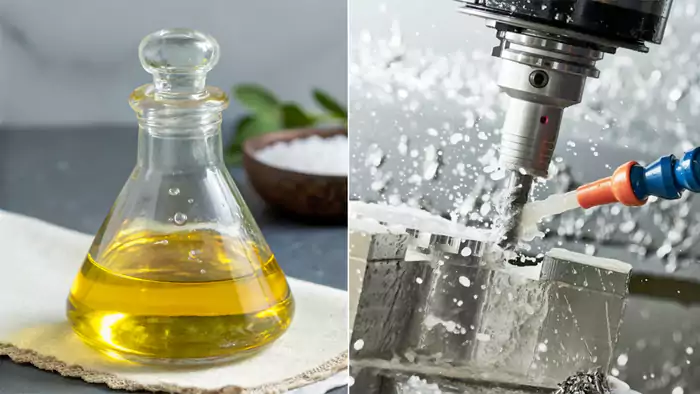
Manufacturing Case Study:
We recently optimized cutting fluid for a high-volume automotive component manufacturer. Their previous fluid was causing excessive tool wear on 4140 steel components. By switching to a semi-synthetic fluid with enhanced EP additives, we achieved:
| Parameter | Previous Fluid | Optimized Fluid | Improvement |
|---|---|---|---|
| Tool Life | 120 parts/tool | 280 parts/tool | 133% increase |
| Surface Finish | Ra 1.8 μm | Ra 0.6 μm | 67% smoother |
| Fluid Change Interval | 3 months | 6 months | 100% longer |
| Scrap Rate | 4.2% | 1.1% | 74% reduction |
The composition of a cutting fluid is a careful balance, much like a recipe, where each ingredient plays a critical role. I remember working on a particularly tough stainless steel job. We were burning through tools until we switched to a fluid with a higher concentration of extreme pressure additives1. It made all the difference.
Base Oils: The Foundation
The base oil is the primary lubricating component.
- Mineral oils: These are derived from petroleum and are widely used due to their good lubricating properties and cost-effectiveness. They are common in straight oils and as the oil phase in emulsions.
- Synthetic oils2: These are man-made and can be engineered for specific properties, like high-temperature stability or improved lubricity. Examples include polyalphaolefins (PAOs) and esters. They often offer better performance but can be more expensive.
- Vegetable oils: Derived from plants, these are biodegradable and offer excellent lubricity. However, they can be prone to oxidation and microbial growth if not formulated correctly.
Additives: The Performance Enhancers
Additives are blended into the base oil to enhance or impart specific properties.
- Emulsifiers: Used in water-soluble fluids, they help oil and water mix to form a stable emulsion. Think of how soap helps oil and water mix; emulsifiers do a similar job for cutting fluids.
- Corrosion Inhibitors3: These protect the workpiece and machine tool from rust and corrosion. This is especially important when using water-based fluids.
- Extreme Pressure (EP) Additives4: These react with the metal surface under high pressure and temperature conditions (like those at the tool tip) to form a protective film. This film prevents direct metal-to-metal contact, reducing wear and friction. Common EP additives include sulfurized and chlorinated compounds.
- Anti-wear (AW) Additives: These form a protective layer on metal surfaces to reduce wear under less severe conditions than EP additives.
- Biocides and Fungicides5: These prevent the growth of bacteria and fungi in water-based fluids, which can cause foul odors, fluid degradation, and health issues.
- Defoamers: These prevent or reduce foam formation, which can be an issue in high-pressure coolant systems.
Understanding these components helps you select a fluid that's tailored to your specific material, operation, and machine. For someone like David, who needs consistent part quality, knowing the fluid chemistry is an advantage.
What are the types of metal cutting fluid available for my machining needs?
Overwhelmed by cutting fluid choices? Knowing the main types simplifies selection and improves results for your specific application.
Metal cutting fluids are generally categorized into four main types: straight oils (neat oils), soluble oils (emulsions), semi-synthetic fluids, and synthetic fluids. Each type offers different cooling and lubricating properties.
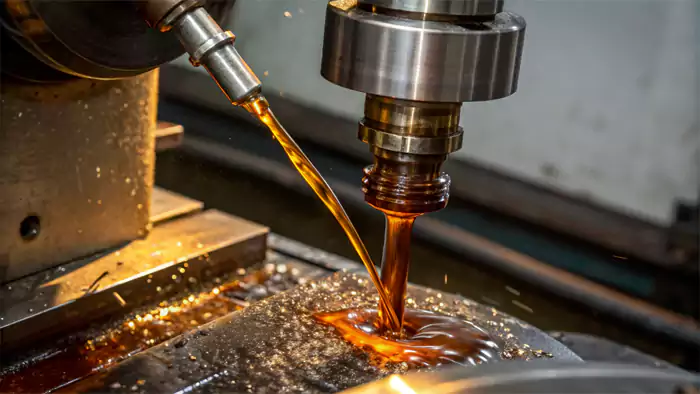
Shop Floor Wisdom:
In our CNC machining services, we maintain a fluid selection matrix based on material and operation type. For high-speed aluminum milling, we prefer semi-synthetics for their balance of cooling and chip evacuation. For tough stainless steel turning, we opt for heavy-duty soluble oils with high EP additive content. This systematic approach has reduced our tooling costs by 18% across our outsourced manufacturing services.
Choosing the right type of cutting fluid is critical. It's not just about pouring any liquid onto the workpiece. I've seen shops make costly mistakes by using the wrong type for the job. For instance, using a fluid with poor cooling on a high-speed aluminum job can lead to a sticky mess and dimensional inaccuracies. Let's look at these types more closely.
1. Straight Oils (Neat Oils)
Straight oils are not mixed with water. They are typically mineral oil-based but can also be animal or vegetable oils.
- Pros: Excellent lubrication, good rust prevention, long sump life.
- Cons: Poor cooling properties, can create smoke and mist, higher fire risk, can be messy.
- Best for: Low-speed operations, tough materials requiring high lubricity like broaching, tapping, and deep hole drilling, especially on non-ferrous metals or some steels.
I remember using straight oils for some heavy-duty threading operations on tough alloys. The lubrication was unmatched, but ventilation was key.
2. Soluble Oils (Emulsions)
These are the most common type. They consist of a mineral oil base with emulsifiers and other additives. They are diluted with water, typically in ratios from 5:1 to 40:1 (water to oil).
- Pros: Good cooling properties (due to water content), good lubrication, cost-effective.
- Cons: Shorter sump life due to bacterial growth if not managed, require proper mixing and concentration control.
- Best for: General-purpose machining on a wide range of ferrous and non-ferrous materials. This is often the go-to for many CNC shops.
3. Semi-Synthetic Fluids
These are a hybrid, containing a smaller amount of mineral oil (typically 5-30%) than soluble oils, along with synthetic lubricants and emulsifiers, diluted with water.
- Pros: Combine good cooling from synthetics and good lubrication from oils, cleaner than soluble oils, better sump life, good rust protection.
- Cons: Can be more expensive than soluble oils, still require some maintenance.
- Best for: A wide range of machining operations, offering a good balance of performance. Many engineers like David appreciate these for their versatility and cleanliness.
4. Synthetic Fluids
These contain no mineral oil. They are chemical solutions mixed with water, often based on organic and inorganic polymers.
- Pros: Excellent cooling, very clean operation, long sump life, excellent microbial control, good visibility of the workpiece.
- Cons: Can offer less lubrication than oil-based fluids (especially for heavy-duty tasks), may cause issues with some machine seals or paints, can sometimes leave sticky residues.
- Best for: High-speed grinding and machining operations where cooling is paramount, especially on ferrous metals. They are also good when cleanliness is a major concern.
Here's a quick comparison:
| Fluid Type | Lubrication | Cooling | Cleanliness | Sump Life | Cost | Typical Use |
|---|---|---|---|---|---|---|
| Straight Oils | Excellent | Poor | Fair | Long | Moderate | Low-speed, heavy-duty, tough materials |
| Soluble Oils | Good | Good | Fair | Moderate | Low | General purpose machining |
| Semi-Synthetics | Good | Very Good | Good | Good | Moderate | Versatile, wide range of operations |
| Synthetics | Fair | Excellent | Excellent | Very Long | High | High-speed, grinding, where cooling is key |
Selecting the correct type involves considering the material being machined, the type of operation, speed, feed rates, and machine tool compatibility.
Can you use WD-40 as a cutting fluid, or is that a bad idea?
Facing a quick machining task and reaching for WD-40? It's tempting, but is it truly effective or potentially harmful?
No, WD-40 is not recommended as a primary cutting fluid for most machining operations. While it offers some lubrication and water displacement, it lacks the cooling capacity, extreme pressure additives, and stability of dedicated cutting fluids.
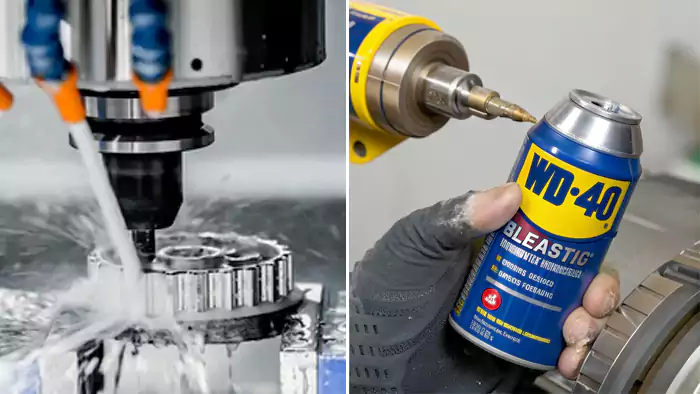
Production Reality Check:
We once had a client who tried using WD-40 for their aluminum prototype runs to "save money." The result: tool life dropped from 50 hours to just 8 hours, surface finish quality deteriorated by 40%, and they spent more on replacement tools than they would have on proper cutting fluid. As an experienced outsourced manufacturing services provider, we always advise against such shortcuts.
I get asked this question surprisingly often, especially by hobbyists or those new to machining. WD-40 is a fantastic product for many things – loosening stuck parts, displacing moisture, light lubrication. However, for serious metal cutting, it falls short. Think of it like using cooking oil in your car engine; it might work for a moment, but it's not designed for the job and will lead to problems.
Why WD-40 Isn't Ideal for Machining
- Low Flash Point and Smoke: WD-40 has a relatively low flash point. The heat generated during machining, especially on tougher materials or at higher speeds, can cause it to smoke excessively or even ignite. This is a safety hazard and creates an unpleasant working environment. I've seen small jobs where WD-40 was used, and the amount of smoke was quite alarming.
- Insufficient Cooling: The primary function of WD-40 is water displacement and light lubrication, not cooling. Machining generates significant heat at the tool-workpiece interface. Dedicated cutting fluids, especially water-based ones, are formulated to carry this heat away effectively. WD-40 cannot do this, leading to tool overheating, reduced tool life, and potential damage to the workpiece.
- Lack of Extreme Pressure (EP) Additives: Most serious machining operations require fluids with EP additives. These additives form a protective film under the high pressures and temperatures at the cutting edge, preventing welding and reducing friction. WD-40 does not contain these specialized additives in sufficient amounts for demanding cutting tasks.
- Residue: WD-40 can leave a sticky residue that might be difficult to clean and could interfere with subsequent operations like painting or coating. Dedicated cutting fluids are often designed to leave minimal or easily cleanable residues.
- Cost-Effectiveness for Continuous Use: While a can of WD-40 might seem cheap for a one-off, very light task, it's not cost-effective for continuous or production machining compared to properly diluted cutting fluids.
When Might WD-40 Be Okay (with caveats)?
For extremely light-duty, short-duration tasks on soft materials like aluminum, where you're drilling a single hole at low speed, WD-40 might be slightly better than cutting dry. However, even then, a proper cutting fluid or even a drop of tapping fluid would be superior. I sometimes use it to free up a stuck tap in aluminum, but that's about its limit in my machining world.
For engineers who are focused on precision, consistency, and optimizing production, relying on WD-40 as a cutting fluid is simply not a viable option. It doesn't provide the performance or reliability needed for professional CNC machining services. Always opt for a fluid specifically designed for the metal cutting process at hand.
What is the most commonly used cutting fluid in workshops today?
Wondering which cutting fluid dominates the shop floor? Knowing the most popular choice can provide a good starting point for many applications.
Soluble oils (emulsions) are generally the most commonly used cutting fluids in CNC machining workshops. Their balance of good cooling, adequate lubrication, versatility across various materials and operations, and cost-effectiveness makes them a popular choice.
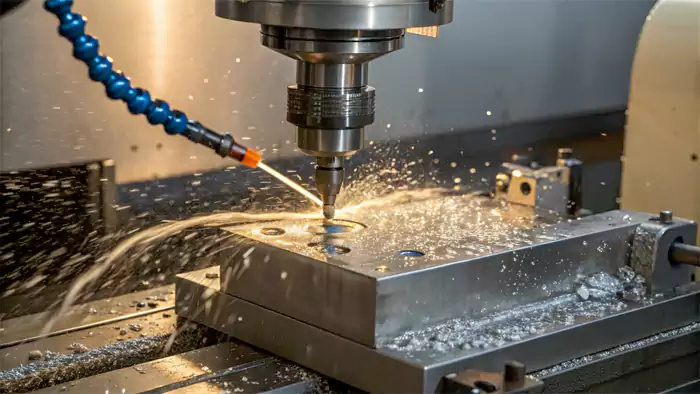
In my years running Allied Metal and working in various shops, I've seen soluble oils used more than any other type. They really hit a sweet spot for many general machining tasks. When you walk into a typical job shop or a production facility, there's a high chance the machines are running with a milky white or semi-translucent emulsion – that's soluble oil or a close relative, the semi-synthetic.
Why Soluble Oils are So Popular
- Versatility: They can be used for a wide range of machining operations, including turning, milling, drilling, and grinding. They also work well with many different metals, both ferrous (like steel and cast iron) and non-ferrous (like aluminum and brass). This makes them a great all-rounder.
- Cooling and Lubrication Balance: The water content in soluble oils (they are mixed with water, typically at 5% to 10% concentration) provides excellent cooling. This is crucial for dissipating the heat generated during cutting, which helps prolong tool life and maintain dimensional accuracy. The oil component provides the necessary lubrication to reduce friction between the tool and the workpiece.
- Cost-Effectiveness: Compared to straight oils or full synthetics, soluble oils are relatively inexpensive. You buy a concentrate and dilute it with water, so the per-gallon cost of the working fluid is quite low. This is a big factor for many shops, especially those looking to manage operational costs without sacrificing too much performance – a key concern for engineers like David managing budgets.
- Operator Acceptance: They are generally cleaner to work with than straight oils, producing less smoke and mist. While they require maintenance to prevent bacterial growth, modern formulations have improved significantly in this regard.
The Rise of Semi-Synthetics
While soluble oils are king, semi-synthetic cutting fluids are also very common and gaining popularity. They offer a step up in performance from traditional soluble oils, providing better cleanliness, longer sump life, and often improved rust protection, while still maintaining good cooling and lubrication. For many shops, semi-synthetics offer an excellent compromise between the cost of soluble oils and the higher performance (and cost) of full synthetics. I've personally transitioned many jobs to semi-synthetics for their enhanced stability and reduced maintenance.
Factors Influencing Choice
Even though soluble oils are common, the "best" fluid always depends on the specific application. Factors include:
- Material being machined: Tough alloys might need fluids with more EP additives.
- Type of operation: Grinding needs excellent cooling (favoring synthetics or high-water soluble oils).
- Severity of operation: Heavy cuts need more lubrication.
- Machine tool requirements: Some machines have specific fluid compatibility.
- Environmental and health regulations: Driving a shift towards more operator-friendly and environmentally benign fluids.
So, while soluble oils are the workhorse, the trend is towards fluids that offer better performance, longer life, and are safer for operators and the environment.
Why are Cutting Fluids so Important in Metal Cutting?
Are you underestimating the role of cutting fluid in your machining? Its impact goes far beyond just a bit of cooling.
Cutting fluids are critically important in metal cutting because they provide essential cooling and lubrication, flush away chips, prevent corrosion, and improve surface finish and dimensional accuracy. This leads to longer tool life and higher quality parts.
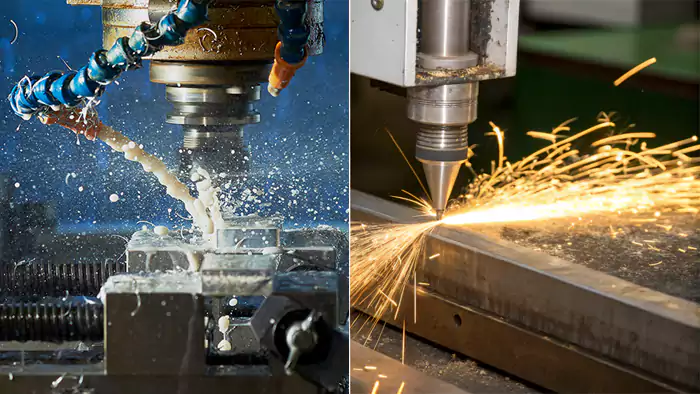
Performance Data from Our Shop:
In our CNC machining services, we track fluid performance metrics religiously. For a recent aerospace component project involving Inconel 718, proper fluid selection delivered:
- 65% reduction in tool consumption
- Surface finish improvements from Ra 2.1μm to Ra 0.7μm
- Dimensional consistency within ±0.012mm across 500 parts
- Elimination of thermal distortion in thin-walled sections
When I first started my CNC machining journey as an employee, I saw firsthand how vital cutting fluids are. My mentor used to say, "The fluid is as important as the tool itself." He was right. My insights confirm that they keep things cool and smooth, prevent wear, frictional overheating, and surface roughness. For engineers, pursuing precision and efficiency in industrial automation components is of paramount importance.
The Core Functions and Their Impact
Let's break down exactly why these fluids are indispensable:
- Cooling:
- Problem: Metal cutting generates intense heat at the shear zone and the tool-chip interface. This heat can damage the tool (leading to rapid wear or failure), distort the workpiece (causing inaccuracies), and even alter the material's properties.
- Solution: Cutting fluids, especially water-based ones, absorb and carry away this heat.
- Benefit: Longer tool life, better dimensional stability of the part, prevention of thermal damage to the workpiece surface. I've seen tools glow red hot when coolant systems failed – a clear demonstration of the heat involved.
- Lubrication:
- Problem: High friction occurs between the cutting tool, the chip, and the workpiece. This friction generates more heat, increases cutting forces, accelerates tool wear, and can lead to a poor surface finish (e.g., built-up edge formation).
- Solution: Cutting fluids create a lubricating film that reduces this friction.
- Benefit: Reduced tool wear, lower cutting forces (meaning less power consumption), improved surface finish, and prevention of chip welding to the tool.
- Chip Removal (Flushing):
- Problem: Chips produced during cutting can clog the cutting zone, get re-cut by the tool, or mar the workpiece surface. This is especially critical in operations like drilling or deep slot milling.
- Solution: The flow of cutting fluid helps to flush chips away from the cutting area.
- Benefit: Clearer cutting zone for better process stability, improved surface finish, prevention of tool damage from chip jamming. High-pressure coolant systems are specifically designed to maximize this effect.
- Corrosion Prevention:
- Problem: Freshly machined metal surfaces, especially ferrous ones, are highly susceptible to rust and corrosion, particularly when exposed to air and moisture (which is abundant in water-based coolants). Machine tools themselves can also corrode.
- Solution: Cutting fluids contain corrosion inhibitors that form a protective layer on the metal surfaces.
- Benefit: Protection of the finished part and the machine tool, ensuring longevity and quality.
- Improved Surface Finish and Accuracy:
- Problem: Without proper cooling and lubrication, issues like built-up edge (BUE), tearing, and thermal distortion can ruin the surface finish and dimensional accuracy of the part.
- Solution: By controlling temperature, reducing friction, and aiding chip evacuation, cutting fluids contribute directly to a smoother, more accurate machined surface.
- Benefit: Parts meet tighter tolerances and have better aesthetic and functional surfaces. This is crucial for the high-accuracy components David designs.
In essence, cutting fluids are not just an accessory; they are an active participant in the machining process, enabling higher cutting speeds, deeper cuts, longer tool life, and better overall part quality. Investing in the right fluid and its proper management pays off significantly.
What is a good substitute for cutting fluid?
What if I don't have the right cutting fluid when CNC machining metal parts? While not ideal, some common items might offer temporary help for very light tasks.
For very light, occasional tasks on soft metals, a drop of mineral oil, general-purpose lubricating oil, or even soapy water can be a temporary substitute. However, these lack the specific properties of dedicated cutting fluids and are not suitable for serious machining.
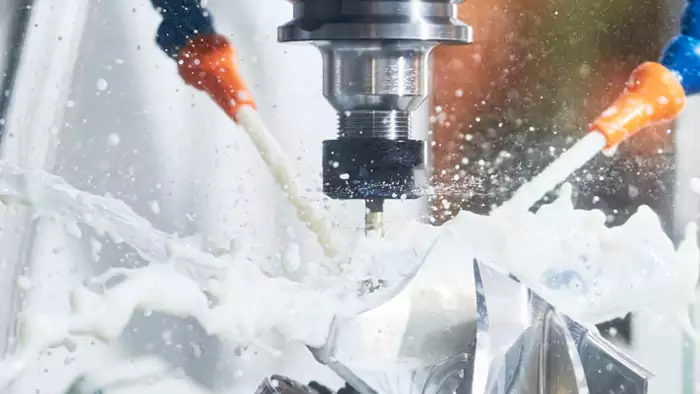
Quality Assurance Note:
As an outsourced manufacturing services provider, we maintain strict protocols against using substitutes in production environments. All our CNC machining services use only certified cutting fluids with documented performance data and material compatibility testing. This ensures consistent quality and prevents costly rework or warranty claims.
There have been times, especially early in my career or when working on a quick, non-critical repair outside the main shop, when I didn't have the ideal cutting fluid on hand. While I can't stress enough that proper cutting fluid is always best, let's explore what might work in an absolute emergency for very limited situations. This is not advice for production or anything requiring precision like David's work.
Potential Temporary Substitutes (Use with Extreme Caution)
Remember, these are last-resort options for very low-speed, light-duty operations on soft materials like aluminum or mild steel, typically for manual operations like hand drilling or tapping a single hole.
- Mineral Oil / General Lubricating Oil (e.g., 3-in-1 Oil, Motor Oil - clean):
- How it helps: Provides some lubrication, reducing friction.
- Limitations: Poor cooling, can smoke, not designed for cutting pressures, lacks EP additives.
- When: Maybe for slowly hand-tapping a soft aluminum hole. I've used a drop of motor oil when drilling a hole in a pinch on a non-critical bracket, but it was slow going.
- Soapy Water (Dish Soap and Water):
- How it helps: Water provides some cooling, soap can offer a little lubricity and help wet the surface.
- Limitations: Very poor lubrication, can cause rust quickly if not cleaned off, not for high speeds or tough materials.
- When: Perhaps for hand-sawing a piece of aluminum or very slow drilling where cooling is the main, minimal concern.
- Water (Plain):
- How it helps: Provides cooling.
- Limitations: No lubrication, promotes rust very quickly on ferrous metals.
- When: Rarely advisable, but better than nothing for cooling if drilling something like plastic very slowly where melting is the only concern. Not for metals generally.
Why Substitutes are Risky
Using these substitutes carries risks:
- Poor Tool Life: Lack of proper lubrication and cooling will wear out your tools (drill bits, taps, end mills) very quickly.
- Bad Surface Finish: You're likely to get a rough, torn surface.
- Inaccurate Parts: Thermal expansion and poor cutting action can lead to oversized or out-of-spec parts.
- Safety Hazards: Some oils can smoke excessively or have low flash points.
- Machine Damage: Using the wrong fluid (or none) can put extra strain on your machine's spindles and motors. Rust is also a major concern.
For anyone doing serious machining, like the custom CNC work we do at Allied Metal, or for engineers like David specifying parts, relying on substitutes is out of the question. The cost of a failed part, a broken tool, or damage to a multi-thousand-dollar machine far outweighs the cost of proper cutting fluid.
If you find yourself needing to machine and don't have the right fluid, the best advice is to wait and get the correct product. It's a small investment that protects your tools, your workpiece, and your machine.
Conclusion
Metal cutting fluid is essential for efficient machining, providing cooling, lubrication, and chip removal, ultimately extending tool life and improving part quality. For businesses seeking reliable CNC machining services or considering an outsourced manufacturing services provider, understanding cutting fluid technology demonstrates the level of expertise required for successful production outcomes. The right fluid selection and management can significantly impact your bottom line through reduced tooling costs, improved quality, and increased production efficiency.
Footnotes:
-
Understanding extreme pressure additives can enhance your knowledge of cutting fluid performance and tool longevity. ↩
-
Explore the advantages of synthetic oils, including their performance and stability, to make informed choices for your lubrication needs. ↩
-
Learn how corrosion inhibitors protect machinery and enhance longevity, ensuring your equipment remains in top condition. ↩
-
Discover how EP additives enhance performance under high pressure, reducing wear and extending the life of your tools. ↩
-
Understand the role of biocides and fungicides in maintaining fluid quality and preventing health issues in industrial applications. ↩


Man, trying to remember passwords is a pain. jili30login saved me. Easy to access my account. No hassle. Super simple login process! Peep it: jili30login